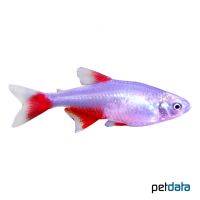Bloodfin Tetra (Aphyocharax anisitsi)
| Bloodfin Tetra Aphyocharax anisitsi | |
|---|---|
| Name | Bloodfin Tetra |
| Name Lat. | Aphyocharax anisitsi |
| Synonym | Aphyocharax rubripinnis |
| Family | Characins |
| Family lat. | Characidae |
| Order | Characins |
| Order lat. | Characiformes |
| Origin | South America |
| Habitat | Streams |
| Diet | Carnivore |
| pH | 6.0-8.0 |
| Behavior | Peaceful |
| Keeping | Group |
| Care Level | Easy |
| Reproduction | Egg scatterer |
| Breeding | Moderately difficult |
| Life Span | 3-5 years |
| Protection | No |
| Metric Units | |
| Size | 5 cm |
| Temperature | 20-25 °C |
| Hardness | < 15 °dH |
| US Units | |
| Size | 2" |
| Temperature | 68-77 °F |
| Hardness | < 267 ppm |
Distribution and habitat
The distribution area of the redfin tetra is the catchment area of the Rio Paranà in Brazil, Paraguay and Argentina. There they live in the slow-flowing streams and small rivers, where they usually reside under overhanging riparian vegetation.
Maintenance
The aquarium should have a dark, sandy substrate, be structured with roots, stones and a dense border and background planting (hiding places) and provide sufficient swimming space. The light should be somewhat subdued (floating plant cover).
No ammonia, ammonium and nitrite should be detectable, the nitrate value should not exceed 100 mg/l. To ensure the water quality and oxygen content, a filter and heater adapted to the aquarium size is required, as well as lighting for the species-appropriate day-night rhythm of the animals.
Diet
In nature they feed mainly on worms, insects and small crustaceans. The food supply consists of live food (cyclops, daphnia, artemia, mosquito larvae, etc.), which is also well accepted frozen, supplemented with high-quality dry food, such as granulated or flake food.
Regular and varied feeding promotes health and prevents deficiency symptoms. Only feed as much as is eaten immediately (in a maximum of 10 minutes).
Behaviour and compatibility
They are peaceful and sociable fish suitable for any community tank. At least 5, but better more redfin tetras should be kept together.
Only mutually compatible fish species with similar requirements for water conditions and water temperature may be socialized.
Sex dimorphism
Males have the finest hooks on the anal fin
Reproduction and breeding
As free spawners, they deposit 300 to 500 eggs randomly between plants. After about 35 hours the young hatch and swim freely after 7 days. The young fish must be fed several times a day with special rearing food (infusoria, Artemia nauplii, dust food).
In a community tank breeding is hardly possible, because the spawn is easy prey here.
Important
Redfin tetras can live for over ten years.
The well-being of the fish should be checked regularly. The temperature should be checked daily, the pH, hardness and nitrate value at least every 14 days. Regular partial water changes are recommended, even if the contaminant level has not yet reached the upper limit. Sudden changes in water quality should be avoided. Newly introduced fish must be accustomed slowly to the water in the aquarium.
Further literature can be found in your pet store.
References
Text: Sabina Lamboj; Image: petdata
Source: BMELV (1998): Tierschutzgutachten - Haltung von Zierfischen (Süßwasser); RIEHL & BAENSCH (2006): Aquarien Atlas Bd. 1, Mergus Verlag; BAENSCH & RIEHL (2004): Aquarien Atlas Bd. 2, Mergus Verlag; ENGELMANN (2005): Zootierhaltung - Tiere in menschlicher Obhut: Fische, Verlag Harri Deutsch
- Gemäß § 21 Abs. 5 Tierschutzgesetz idgF
